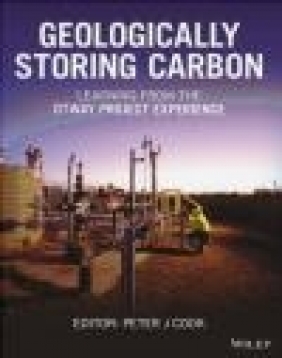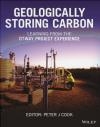Geologically Storing Carbon: Learning by Doing
Peter Cook
Geologically Storing Carbon: Learning by Doing
Peter Cook
- Producent: John Wiley
- Rok produkcji: 2014
- ISBN: 9781118986189
- Ilość stron: 352
- Oprawa: Twarda
Niedostępna
Opis: Geologically Storing Carbon: Learning by Doing - Peter Cook
Carbon capture and geological storage (CCS) is presently the only way that we can make deep cuts in emissions from fossil fuel-based, large-scale sources of CO2 such as power stations and industrial plants. But if this technology is to be acceptable to the community, it is essential that it is credibly demonstrated by world-class scientists and engineers in an open and transparent manner at a commercially significant scale. The aim of the Australian Otway Project was to do just this. Geologically Storing Carbon provides a detailed account of the CO2CRC Otway Project, one of the most comprehensive demonstrations of the deep geological storage or geosequestration of carbon dioxide undertaken anywhere. This book of 18 comprehensive chapters, written by leading experts in the field, is more than a record of outstanding science- it is about "learning by doing". For example, it explains how the project was organised, managed, funded and constructed, as well as the approach taken to community issues, regulations and approvals. It also describes how to understand the site: Are the rocks mechanically suitable? Will the CO2 leak? Is there enough storage capacity? Is monitoring effective? This is the book for geologists, engineers, regulators, project developers, industry, communities, indeed anyone who wants to better understand how a carbon storage project really works. It is also for people concerned with obtaining an in-depth appreciation of one of the key technology options for decreasing greenhouse emissions to the atmosphere.
I recommend the text to engineers in the field already, or those contemplating CCS work, particularly those interested in cross chain integration and how stores and sources will have to dynamically react to each other. (TCE Today, 1 February 2015
Foreword 1 xi
Foreword 2 xii
Preface xiii
Authors xvii
Acknowledgements xx
1. Developing the Project 1 Peter Cook, Mal Lees, Sandeep Sharma
1.1 Introduction 1
1.2 Developing an Australian project 2
1.3 Developing a suitable corporate structure 10
1.4 Formation of CO2CRC Pilot Project LTD 13
1.5 Funding the project 17
1.6 Designing the Otway Project 22
1.7 Project liability and risk 30
1.8 Conclusions 33
1.9 References 34
2. Communications and the Otway Project 35 Tony Steeper
2.1 Introduction 35
2.2 Strategic communications and the Otway Project 35
2.3 Social research and the Otway Project 40
2.4 Operational issues relating to communications and the community 42
2.5 Conclusions 43
2.6 References 43
3. Government approvals 45 Namiko Ranasinghe
3.1 Introduction 45
3.2 Challenges of regulating a pilot project 47
3.3 Impact assessment and planning approvals 48
3.4 Environmental authority approvals 49
3.5 Petroleum authority approvals 49
3.6 Water authority approvals 51
3.7 Land access and acquisition 51
3.8 Miscellaneous approvals 53
3.9 Transitional arrangements 53
3.10 Liability and responsibility 53
3.11 Stakeholder engagement 54
3.12 Conclusions 55
3.13 References 56
4. Design and operational considerations 57 Craig Dugan, Ian Black, Sandeep Sharma
4.1 Introduction 57
4.2 Options for gas processing 58
4.3 Facilities and pipeline design considerations 64
4.4 Facilities design 66
4.5 Unanticipated operational problems 69
4.6 Conclusions 70
5. Characterising the storage site 71 Tess Dance
5.1 Introduction 71
5.2 Site details 74
5.3 Injectivity 80
5.4 Capacity 81
5.5 Reservoir heterogeneity 83
5.6 Containment 87
5.7 Site analogue 88
5.8 The evolution of the static models 89
5.9 Conclusions 91
5.10 References 92
6. Evaluating CO2 column height retention of cap rocks 97 Richard Daniel, John Kaldi
6.1 Introduction 97
6.2 Mercury injection capillary pressure 98
6.3 Methodology 98
6.4 Pore throat size determination 98
6.5 CO2 contact angle 99
6.6 Determination of seal capacity or column height 101
6.7 Interpreting threshold (breakthrough) pressure 102
6.8 Results for CRC-1 and CRC-2 110
6.9 Conclusions 110
6.10 References 111
7. Geomechanical investigations 113 Eric Tenthorey
7.1 Introduction 113
7.2 Key data for geomechanical assessment of the Otway site 115
7.3 Geomechanical workflow at the Otway site 118
7.4 3D geomechanical modelling 122
7.5 The Iona gas storage facility as an analogue for CO2 storage 123
7.6 Conclusions 126
7.7 References 126
8. Containment risk assessment 129 Maxwell Watson
8.1 Introduction 129
8.2 Methodology 129
8.3 Risk assessment context 131
8.4 Storage complex 131
8.5 Risk items 132
8.6 Risk assessment output 138
8.7 Conclusions 139
8.8 References 139
9. Monitoring and verification 141 Charles Jenkins
9.1 Introduction 141
9.2 Designing a monitoring programme 142
9.3 Designing the Otway monitoring programme 144
9.4 Evaluation of monitoring techniques 148
9.5 Conclusions 151
9.6 References 152
10. 2D and 3D seismic investigations for Stages 1 and 2C 155 Boris Gurevich, Roman Pevzner, Milovan Urosevic, Anton Kepic, Valeriya Shulakova, Eva Caspari
10.1 Introduction 155
10.2 Modelling seismic response of injected CO2 in Stage 1 156
10.3 Modelling seismic response of CO2 leakage for 2C 158
10.4 Time-lapse repeatability in Stage 1 164
10.5 Time-lapse surface seismic monitoring for Stage 1 171
10.6 Downhole seismic methods for Stage 1 177
10.7 Laboratory studies of CO2 acoustic response as an adjunct to field studies 188
10.8 Conclusions 192
10.9 References 193
11. Seismic and microseismic monitoring 197 Tom Daley, Barry Freifeld, Tony Siggins
11.1 Introduction 197
11.2 High resolution travel time (HRTT) monitoring and offset VSP 197
11.3 Passive seismic monitoring 207
11.4 Microseismic monitoring using surface stations 209
11.5 Conclusions 215
11.6 References 216
12. Monitoring the geochemistry of reservoir fluids 217 Chris Boreham, Barry Freifeld, Dirk Kirste, Linda Stalker
12.1 Introduction 217
12.2 Sampling the Buttress-1 well 217
12.3 Sampling the CRC-1 injection well 218
12.4 Sampling the Naylor-1 monitoring well 220
12.5 Injecting tracers at the CRC-1 injection well 224
12.6 Analytical methods 228
12.7 Composition of hydrocarbons 232
12.8 Formation water composition and behaviour 240
12.9 Constraining CO2 breakthrough 241
12.10 In-reservoir behaviour of tracers 244
12.11 Liquid hydrocarbons 245
12.12 Solid hydrocarbons 245
12.13 Conclusions 247
12.14 References 248
13. Monitoring groundwaters 251 Patrice de Caritat, Allison Hortle, Dirk Kirste
13.1 Introduction 251
13.2 Monitoring groundwater level 252
13.3 Monitoring groundwater composition 253
13.4 Interpreting groundwater results 257
13.5 Groundwater composition 260
13.6 Operational issues relating to groundwater monitoring 261
13.7 Quality control 264
13.8 Conclusions 270
13.9 References 270
14. Soil gas monitoring 273 Ulrike Schacht
14.1 Introduction 273
14.2 Surficial geology 274
14.3 Soil gas sampling at Otway 274
14.4 Analysis of soil gas 275
14.5 Soil gas results 276
14.6 Interpretation of soil gas results 277
14.7 Conclusions 279
14.8 References 279
15. Atmospheric monitoring 281 David Etheridge, Ray Leuning, Ashok Luhar, Zoe Loh, Darren Spencer, Colin Allison, Paul Steele, Steve Zegelin, Charles Jenkins, Paul Krummel, Paul Fraser
15.1 Introduction 281
15.2 Sensitivity 282
15.3 Simulated emissions and monitoring design 282
15.4 Background CO2 283
15.5 Data filtering 288
15.6 Bayesian inverse modelling 289
15.7 Conclusions 290
15.8 References 291
16. Reservoir engineering for Stage 1 293 Jonathan Ennis-King, Lincoln Paterson
16.1 Introduction 293
16.2 Description of field data 293
16.3 Well history 297
16.4 Well locations 297
16.5 Well completions 297
16.6 Initial pre-production conditions 297
16.7 Initial fluid compositions 299
16.8 Production data 299
16.9 Post-production conditions 299
16.10 Composition of injected gas 300
16.11 Downhole pressure and temperature during injection 300
16.12 Tracer injection 301
16.13 Gas and tracer sampling 301
16.14 Post-injection conditions 302
16.15 Simulation approach 303
16.16 Dynamic modelling process 308
16.17 Pre-injection modelling results 310
16.18 Injection and post-injection modelling results 312
16.19 Dynamic storage capacity of a depleted gas field 322
16.20 Conclusions 323
16.21 References 324
17. CO2CRC Otway Stage 2B residual saturation and dissolution test 329 Lincoln Paterson, Chris Boreham, Mark Bunch, Tess Dance, Jonathan Ennis-King, Barry Freifeld, Ralf Haese, Charles Jenkins, Matthias Raab, Rajindar Singh, Linda Stalker
17.1 Introduction 329
17.2 Test concept 330
17.3 Injection target 332
17.4 Test sequence 334
17.5 Downhole completion 339
17.6 Measurements 342
17.7 Surface data 342
17.8 Thermal logging 345
17.9 Noble gas tracer tests 345
17.10 Testing phases 345
17.11 Downhole data (memory gauges) 347
17.12 Downhole data (permanent gauges) 347
17.13 Pulsed neutron logging 351
17.14 The organic tracer test 353
17.15 The dissolution test 357
17.16 Conclusions 358
17.17 References 360
18. What was learned from the Otway Project? 361 Peter Cook
18.1 Introduction 361
18.2 Organising a project 363
18.3 Managing a project 364
18.4 Funding a project 365
18.5 Project communications and collaboration 366
18.6 Regulating a project 366
18.7 Identifying a suitable project site 367
18.8 Deciding on project science 367
18.9 Deciding on project monitoring 368
18.10 Curating project data 370
18.11 Lessons for the future? 370
18.12 Conclusions 372
18.13 References 373
Index 375
Szczegóły: Geologically Storing Carbon: Learning by Doing - Peter Cook
Tytuł: Geologically Storing Carbon: Learning by Doing
Autor: Peter Cook
Producent: John Wiley
ISBN: 9781118986189
Rok produkcji: 2014
Ilość stron: 352
Oprawa: Twarda
Waga: 1.66 kg



















